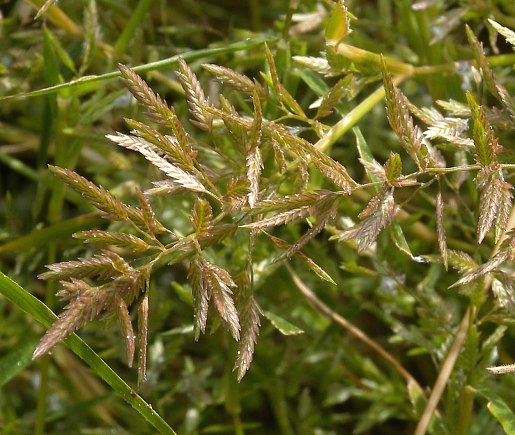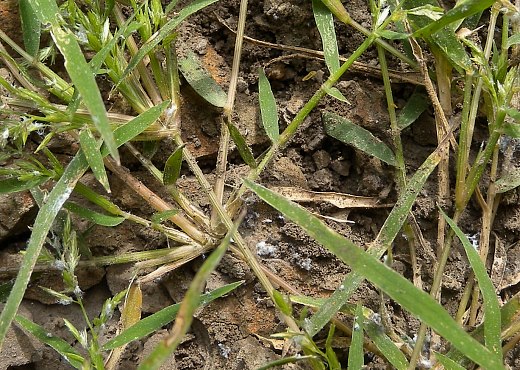Description: This grass is a summer annual, forming a mat of flowering culms about 4-12" high. At the base, each plant develops a tuft of sprawling to ascending culms. Some of these culms develop roots where they touch the ground, producing new plants with flowering culms. The culms are light green, terete, and glabrous; they are largely hidden by the sheaths. Alternate leaves occur along each culm. The leaf blades are up to 3" long and ¼" across; they are dull green, hairless, and flat. The leaf sheaths are rather loose and variably colored; they can be light green, straw-colored, or pale reddish gray. The sheaths are longitudinally veined and mostly hairless, except where they meet the blades, where there are tufts of white hair. Each culm usually branches, producing short lateral culms that often flower. The nodes are slightly swollen and hairy.

Each flowering
culm terminates in a panicle of spikelets about 1-3" long and about
one-half as much across. Each panicle has a central branch and
ascending to spreading lateral branches; the lateral branches divide
into secondary lateral branches. All branches of the panicle are
slender, glabrous, somewhat stiff, and slightly wiry. Each branch tip
terminates in a narrow spikelet of florets about ¼–½" long. Each
spikelet has a pair of glumes (empty scales) at the bottom, above which
there are 10-35 overlapping lemmas (fertile scales) that are arranged
into 2 columnar ranks. Individual lemmas are 1.5–2.0 mm. long,
longitudinally keeled, 3-nerved, and glabrous. The lemmas toward the
bottom of the spikelet are a
little longer than those near the top. The glumes are
similar to the
lemmas, but slightly shorter in length; one glume is longer than the
other. Behind each lemma, there is a single floret that lacks sepals
and petals. The blooming period occurs from late summer to early fall.
The florets are wind-pollinated. Disarticulation of the spikelets is
above the glumes. Fertile florets produce narrow grains about 0.5 mm.
long. The root system is fibrous. This grass reproduces by reseeding
itself; it also spreads vegetatively when its sprawling culms develop
roots after they touch the ground. Large colonies of interconnected
plants are often formed.
Cultivation:
This grass typically occurs in partial to full sun, wet to moist
conditions, and sandy soil. It also adapts to ground that is gravelly,
silty, or muddy. In some situations, it can spread aggressively.
Range & Habitat:
Creeping Love Grass is occasional throughout Illinois, where it is
native. This grass is found
primarily in low disturbed areas along rivers where the soil is sandy,
silty, gravelly, or muddy. At such habitats, this grass is often the
dominant plant species. Other habitats include vernal pools in open
woodlands, low areas along ponds, and sloughs. The seeds of this annual
grass germinate after the season of spring flooding, when water levels
start to recede.
Faunal Relations:
The caterpillars of Hylephila phyleus (Fiery
Skipper), Poanes hobomok (Hobomok Skipper), and Poanes
zabulon (Zabulon Skipper) feed on the foliage of this grass
and other Eragrostis spp. (Love Grasses). Because
Creeping Love Grass often forms large colonies along rivers and other
wetlands, it is occasionally a significant source of food to dabbling
ducks, including Anas acuta (Pintail), Anas
clypeata (Northern Shoveler), Anas crecca
(Green-Winged Teal), and Anas discors (Blue-Winged
Teal).
Photographic Location:
Low ground along the Embarass River at Fox Ridge State Park in
east-central Illinois.

Comments: The most striking thing about this grass is the large dense mats of vegetation that it often forms in disturbed wetland areas. In this regard, it is nearly unique among Eragrostis spp. (Love Grasses). The only other species in this genus that forms mats of vegetation is Eragrostis reptans (Pony Grass). This latter species prefers the same habitats as Creeping Love Grass, but it is less common in Illinois. Unlike Creeping Love Grass, Pony Grass is dioecious, having separate male and female plants. It also differs by having hairy sheaths and longer lemmas (2-4 mm. in length). In addition to Creeping Love Grass, other common names of Eragrostis hypnoides are Pony Grass and Teal Grass.